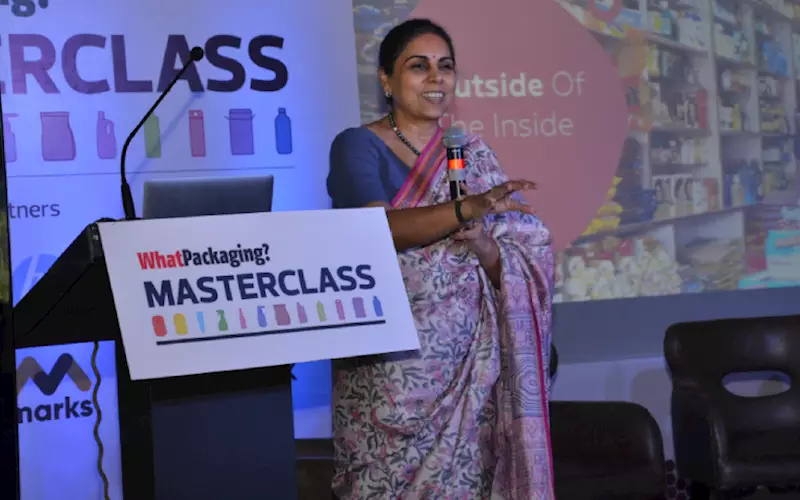Alpana Parida: “Packaging should become a strategic solution to a business problem”
Speaking at WhatPackaging? Masterclass on 29 November, Alpana Parida, managing director, DY Works stressed on packaging’s role in a brand and business strategy
08 Dec 2018 | By WhatPackaging? Team
When clients come to us with packaging design projects, some are looking to change their existing design because it has become old; some say, change the design but not so much that anybody can make out there is a change. When one presents a disruptive idea, the very first reaction one gets is, it will be expensive, it might require a new die and costs could run into several lakhs. This is because very often packaging is seen as a place to cut costs. I tell them, just cut down less than 10% of your advertising production cost or run one advertisement spotless and you will get the money.
At the end of the day when the consumer is buying when they're actually taking out good money from their wallet, they're not paying for that advertisement or even for the product inside because they have not yet experienced the product, what they are paying for is the pack and packaging is absolutely the most critical thing which is the touch point where the consumer pays the money. That is the last place where you should be cutting costs.
Inside of the outside
When I returned from the USA about 12 years ago, I heard about a lot of the toothpastes and hand washes, which were germ-free and they had triclosan. Triclosan is an antibiotic, the continuous of which makes one resistant to a whole lot of other useful bacteria. Therefore, I was looking for triclosan-free toothpaste. I came across a natural toothpaste from a well-known brand (with white and blue packaging). When I opened the tube and squeezed it out, what I got is a brown-coloured toothpaste. Nothing outside had prepared me for this.
Therefore, packaging is not just a story of what the business problem is but it is also about what the product truly is.
There was another brilliant brand called Hippos. They had the highest trials for any snack foods in the country and then the lowest repeats. Because the product was not a fun food, it was baked chips and nothing about the packaging or brand experience prepared the consumer for the boring baked food.
So, packaging is what the consumers buy. Period. Beyond this, there are two marketing truths. One, the shelf is the new battleground. When I graduated in 1985, we were told that the most loyal consumer in the whole world is the Colgate Dental Cream consumer. Today, Colgate has 12 new variants and the loyal consumer doesn’t exist anymore because he or she is bewildered as to what they are buying from the same brands. That was the time when in hair care there were only two categories: hair oil and shampoo and there were maybe three brands. Today, there are 470 brands of shampoos. There has been an explosion in the number of categories, within categories explosion of brands and within brands, the number of variants and further down multiple SKUs and formats. This is how crowded the shelf has become and if you are not winning at this shelf then you are losing market share then and there.
Consumer psyche
According to research, 8% of the consumers are buying the same brand again and again, while 51% of the consumers prefer to buy from the basket. They have a basket of considerations, they will flirt with other brands but at that point, they will see which is the brand that is talking to me and exciting to me and therefore refurbishing packaging and bringing our newer experiences through packaging becomes very important at the shelf.
The conventional wisdom that more you advertise, the more you sell doesn’t work anymore.
Six years ago, there was an advertisement called Dil Titli featuring Saif Ali Khan and Kareena Kapoor. We did a survey across six cities and found that majority of the respondents remembered the advertisement frame by frame, however when we asked what was the brand and category, we got very wrong answers. Advertising can be top of mind awareness but it doesn’t really translate into any recall for a brand and therefore we must understand how critical role packaging plays.
How do we create a packaging that wins on the shelf? The shopper journey comprises of 5S: scanning, searching, spotting, seeking information and selecting. When a consumer comes outside a store, she thinks, is this the kind of store that sells what I’m looking to buy. That means if your product is an impulse category, you should be visible from the outside of the store. When the consumer is at 10-feet from the shelf, the first search for the category, your category has to be evident on the packaging. At five feet, they start looking at the brand and the variants. Then they are looking at specific variants and specific benefits. There’s an information hierarchy in packaging design, it has to reflect the customer’s journey.
If you define the problem, your solutions will be a different basis for the problem. If your problem is gaining market share, your product really needs to stand out vis-à-vis the competitor. For example, if there is a light milk and there are other slim variants, a promise of what the product benefit is should be more prominent than anything else. Think about Amul Kool. It used to be a lassi in a Tetra Pak. When they changed the format to bottle, it changed the passive habit of drinking from a carton with a straw like a child to drinking it like a bottled soft drink. This packaging shift alone has led to over 400% increase in sales.














 See All
See All